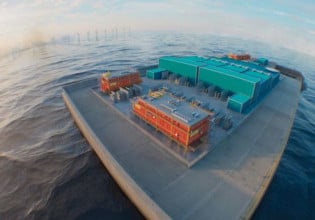On a Power Journey: Young and Ambitious–How Nexperia Delivers on its Aspiring Plans for Growth
Just five years ago, European headquartered Nexperia entered the semiconductor market as an independent entity. The former Standard Products division of NXP started out with an annual revenue of about $1.1 billion. Today, this number has already exceeded the $2.1 billion mark. By 2030 Nexperia plans to reach $10 billion in revenue. I had the chance to interview Toni Versluijs, General Manager Business Group MOS Discretes, and Mark Roeloffzen, General Manager Business Group Bipolar Discretes.
Just five years ago, European-headquartered Nexperia entered the semiconductor market as an independent entity. The former Standard Products division of NXP started out with an annual revenue of about $1.1 billion. Today, this number has already exceeded the $2.1 billion mark.
Bodo: Even though Nexperia is a fairly young company, it demonstrates remarkable growth. What is the recipe for the success we have seen lately?
Mark Roeloffzen: Yes, our development since inception has been truly extraordinary. Definitely, one reason for this is that we were able to build upon a solid foundation with a strong track record in semiconductor manufacturing over several decades. Another major aspect is the fact, that right from the beginning our leadership has been committed to a continuous global investment strategy – in research and development, production capacities and, above all, people. At the end of the day, it sounds simple, but I would say this: TeamNexperia managed to deliver on innovative products that our customers need.
And it is this TeamNexperia that enabled us to become a leading expert in the high-volume production of essential semiconductors. With our 15,000 product-strong portfolio, we serve virtually every electronic design in the world. In 2021 our employees across the globe added more than 800 new products to the line, all while also shipping more than 100 billion units in 2021. Our customers appreciate that we consistently deliver on reliability and efficiency. As a result, we made a name for ourselves relatively quickly and recently saw a 49 percent year-on-year increase in our total revenue, massively outperforming the overall semiconductor market which grew by 30% in 2021.

Mark Roeloffzen. Image used courtesy of Bodo’s Power Systems
Bodo: What are some examples of recent investments?
Toni Versluijs: Our focus is always to keep up with the needs of our customers. Last year we saw record CAPEX spending in Europe and Asia, tripling the outlay from the previous year. Key examples include further expanding production capacities in our European wafer fabs, as well as the acquisition of a semiconductor production facility in Wales – Nexperia Newport. This new facility, where we continue to invest in equipment and people, complements our strong European manufacturing operation.
And most recently, we are about to launch a new design center in Dallas, Texas. This is the first research and development facility we have in North America. The growing team here will focus on the development of analog signal conversion and power management ICs. This represents an important company milestone for Nexperia.
Bodo: In what sense?
Toni Versluijs: Well, it is quite simple, when you take the megatrends of the semiconductor industry into account. Connectivity and digitalization, electrification, industry 4.0 and automation, sustainability, and energy efficiency open considerable opportunities in terms of power management and signal conversion. For example, each electric vehicle requires four to six times more semiconductors than a conventional car. It is also predicted that by 2030, 80% of the global population will be connected via 5 and 6G technology, and the mobile segment will grow as the demand for smartphones further increases.
We want to capture these opportunities by strengthening and expanding our portfolio with more complex and high-power products. This means we are transitioning from commodity towards more differentiated and unique products.

Toni Versluijs. Image used courtesy of Bodo’s Power Systems
Bodo: Does that mean you are changing your company strategy entirely?
Mark Roeloffzen: Not really. This is all part of our long-term strategy which will enable us to transition into a world leader in essential semiconductors with a revenue of more than $10 billion by 2030. The strength of our brand has been built on our existing portfolio of essential semiconductors like logic, discretes and power MOSFETs.
In 2021 we have established two new business groups: IGBTs & Modules, and Power & Signal Conversion. These two new business groups, in combination with the existing business groups, target to further expand our offering in the power discrete domain like SiC, GaN, MOSFETs, IGBTs, Power Modules, Analog ICs and SystemIn-Package solutions. This extended range will enable us to better serve our customers and market requirements in the severe growing power domain. Next to the impact made on a power-efficient world, the focus on profitable growth by innovation will help us to become the number one in the segments we operate in.
Bodo: That sounds like an ambitious plan for the portfolio. How do you intend to make that happen?
Toni Versluijs: That is correct, reaching that goal means a significant shift within our portfolio. If we look back at 2017 for example, differentiated and unique products made up roughly 40%. We are now striving to grow to have a much more advanced portfolio by 2030, where that portion will grow up to 85%. As part of this plan, we are working closely with our strategic customers to ensure early roadmap alignment and timely design-in, which will lead to a higher percentage of sales of innovative products.
To deliver these products in the high volumes required, we are expanding our technology, manufacturing capacity and workforce, through significant additional investments.
Bodo: Can you be more specific, please?
Mark Roeloffzen: We now have record investments in research and development. In 2022, we will increase our R&D investment by more than 50 percent when compared to 2021. The R&D spend as a percentage of our sales will continue from about 10% today to 15% over time, helping us to differentiate ourselves in the marketplace by having an innovative portfolio that allows us to grow faster and more profitably.
Furthermore, we are investing in new production capacity, like 12 inches as well as building more strategic partnerships with external foundries and subcontractors that will play a vital role in our future growth. Compared to 2021, the investments in CAPEX will double.
And last, but not least, our people are key to our success. We need to further expand our 14,000+ strong TeamNexperia by hiring additional talent for a variety of functions, with a strong focus on development roles. Here, our strategy is to hire talented people “where they are” – by establishing and developing design centers around the globe close to known talent pools like Penang, Shanghai, Newport, Dallas and more to come.
Bodo: As a global player, where do you see your responsibilities in terms of sustainability?
Toni Versluijs: One of the biggest challenges of our generation is meeting the increasing energy demand. And while the global electricity consumption per capita has grown by 50% in the last 30 years, there seems to be no end in sight. We are still witnessing a boom in consumer technology with mobile phones, computers, and laptops all requiring power for charging as well as for the supporting communication infrastructure. Moreover, there are motors of all sizes where we’ve never seen motors before – from recliner seats and garden tools to lifebelts.
As a power semiconductor maker, we have been placed in a position of responsibility as our products are carbon-neutral enablers. As engineers, we must deliver improvements in power conversion efficiency, which will require solutions other just than standard silicon. Here is an open window for wide bandgap semiconductors (WBG) to play an important role in taking on the challenges of the next decades.
At Nexperia, sustainability is firmly embedded in the way we do business, as we believe an efficient company creates efficient products. We as a company hold part of the key to an energy-efficient future, a responsibility we take very seriously.
Bodo: Are silicon carbide (SiC) and gallium nitride (GaN) the answer to the energy challenge?
Toni Versluijs: For relatively new technologies SiC and GaN are already efficiently outperforming traditional silicon and still have so much potential! But there is an arsenal of technology options available, and there is room for all. Each technology will have its own sweet spot which will change over time, suiting different application requirements depending on the trade-off between performance, cost, and availability.
Today, silicon is widely used through decades of evolutionary improvements. GaN will proceed similarly given all the R&D work and investment that are in progress. Power GaN has already proven its worth in many low-power applications, facilitating more compact and higher efficiency solutions. We are pushing GaN to even higher power levels, providing solutions from 2 kW all the way up to 250 kW. We have even worked with customers to demonstrate that at 650 V these power levels are achievable. For the voltage ranges above 650 V, we are developing a SiC rectifier and SiC FET portfolio. This will assure that in due time we will have a full WBG portfolio comprising GAN and SiC.
In addition, Nexperia is developing other adjacent technologies to best address the high voltage power semiconductor market such as IGBT, HV MOS or recovery rectifiers. We strongly believe that the best solution for each different customer application depends on balancing performance, cost, and supply. Thus, Nexperia will offer all technologies, so we offer a choice for every customer trade-off.
Bodo: Thank you both for your time and for these insightful answers. I will keep my eyes open for more to come from Nexperia!






